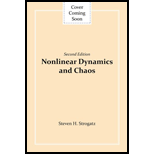
Interpretation:
Consider the weakly nonlinear oscillator
Show that
Let
Show that
Show that
Concept Introduction:
The expression for the averaging equation for magnitude is
The expression of initial displacement
The expression of the amplitude of any limit cycle for the original system is
The expression of the frequency of any limit cycle for the original system is
Taylor series expansion of
Answer to Problem 25E
Solution:
The result
The result
The result
The results
Explanation of Solution
The expression for the averaging equation for magnitude is:
Here, x is the position and
The expression of initial displacement
Here,
The expression of the amplitude of any limit cycle for the original system is
The expression of the frequency of any limit cycle for the original system is:
Here,
Taylor series expansion of
Here,
(a)
The first derivative of
The system equation is:
And,
Differentiate function
Substitute
Further differentiate the function
Substitute
From the above calculation of
Multiply
Therefore, the equation is:
Add the above two expression,
Multiply
Adding the above expressions,
Hence, expression of
(b)
The expression for
From Leibniz’s integral rule, considered the function
Differentiate the above expression,
Hence, expression
(c)
Substitute
Substitute
Therefore the expression of
(d)
The magnitude and phase expression for the system equation is calculated as:
Apply Taylor series expansion of
The above expression is true only because the average value of one oscillation and the rate of change over that cycle,
Therefore, from above expression for
Therefore, the expression of
Want to see more full solutions like this?
Chapter 7 Solutions
Nonlinear Dynamics and Chaos
 Advanced Engineering MathematicsAdvanced MathISBN:9780470458365Author:Erwin KreyszigPublisher:Wiley, John & Sons, Incorporated
Advanced Engineering MathematicsAdvanced MathISBN:9780470458365Author:Erwin KreyszigPublisher:Wiley, John & Sons, Incorporated Numerical Methods for EngineersAdvanced MathISBN:9780073397924Author:Steven C. Chapra Dr., Raymond P. CanalePublisher:McGraw-Hill Education
Numerical Methods for EngineersAdvanced MathISBN:9780073397924Author:Steven C. Chapra Dr., Raymond P. CanalePublisher:McGraw-Hill Education Introductory Mathematics for Engineering Applicat...Advanced MathISBN:9781118141809Author:Nathan KlingbeilPublisher:WILEY
Introductory Mathematics for Engineering Applicat...Advanced MathISBN:9781118141809Author:Nathan KlingbeilPublisher:WILEY Mathematics For Machine TechnologyAdvanced MathISBN:9781337798310Author:Peterson, John.Publisher:Cengage Learning,
Mathematics For Machine TechnologyAdvanced MathISBN:9781337798310Author:Peterson, John.Publisher:Cengage Learning,






